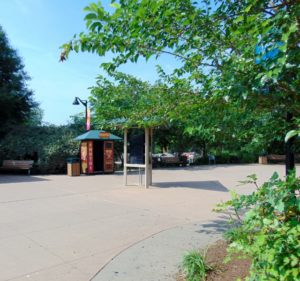
Overall Rating![]()
The Little Rock Zoo was founded in 1926, and is located in Little Rock, Arkansas. The Zoo sits on 33 acres. They have approx. 725 animals representing approx. 200 species. The Little Rock Zoo is an accredited member of the Association of Zoos and Aquariums (AZA). Inside the Zoo are exhibits such as Great Apes, Primates Reptiles Birds & More, Asian Elephants, Africa & African Savanna, Bears, & Small Carnivores.
Little Rock Zoo Website: www.littlerockzoo.com
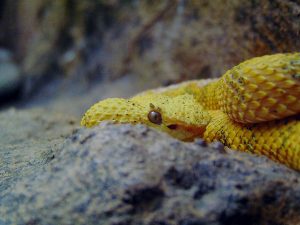
Hours:
October 16th-Febuary 28th
9:00am–4:00pm
March 1st-October 15th
9:00am-5:00pm
Ticket Pricing:
Adults $12.95
Seniors (60+)-$10.95
Kids (3+)-$9.95
Parking: $3.00
Restaurants/Concession:
Café Africa-Open 7 days/week
Spring & Summer Hours
9:30am-5:00pm (kitchen closes at 4:30pm)
Winter Hours
Monday & Tuesday-9:30am-2:00pm
Wednesday-Sunday-9:00am-4:00pm (grill closes at 3:30pm)
Mosi’s Snack Shack-Seasonal
Open Weekend during Spring & Summer months
No outside food or drinks allowed with the exception of refillable bottle of water.
Pet Daycare: Unknown
Service Dogs: Unknown
With any extra service provided I would always call ahead for any information.
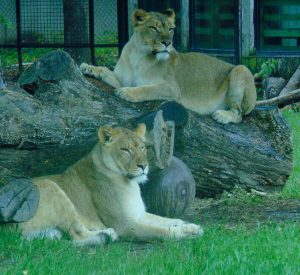
Animal Habitats![]()
Education![]()
Cultural Immersion![]()
Navigation![]()
Food Variety![]()
For more information on our ratings click here.
Our Zoo Experience
Steve and I visited the Little Rock Zoo this past May (2018). Little Rock Zoo is 33 Acres, however, for the space they utilized the acreage very well. It wasn’t too compact where the animals and their habitat suffered.

You know when I tell you how many acres a zoo is, it includes everything. So it is not 33 acres of walkable area. With that in mind, let’s talk about Little Rock Zoo.
We stayed just outside Little Rock in Bryant, it was about an eighteen minute drive to the zoo. We got there right before they opened at 9 am.
When you enter the zoo you have a couple of options on the direction you can walk through the zoo. We choose to go right.
Our thinking was the cats would be up moving around earlier in the day. We wanted to see them before they took their cat naps in the heat of the day.
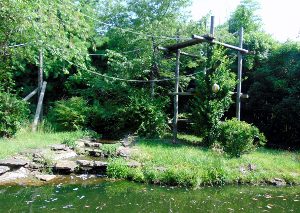
The first habitat we came upon belonged to a species of primate called Siamang. They have a beautiful habitat with two islands, lots of shade, and nice areas for climbing and overlooking their domain.
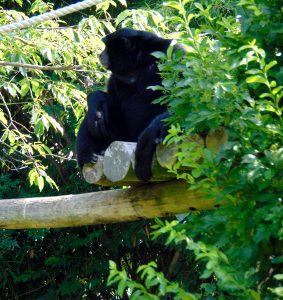
The Gibbon habitat was being renovated so they were not on exhibit the day we were there. After visiting the Siamang’s we went across the trail to Penguin Pointe.


The Penguin Pointe trail looped around the African Black-footed Penguin habitat. When you round the corner and come down the trail the front of the exhibit looks like a shipwreck.
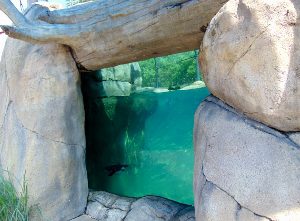
There are two viewing (underwater) areas which allow you to see the Penguins swimming.
The educational signage along the trail is great. The zoo broke the Penguins up into groups, starting with the Crested Penguins.

They also had the Largest & Smallest Penguins listed.

Stiff Tailed Penguins and Tropical Penguins signs were at the end of the trail.
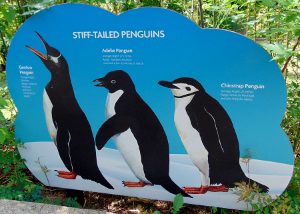
As we headed back across the trail we came to Ground Hornbill sharing a habitat with Greater Kudu.
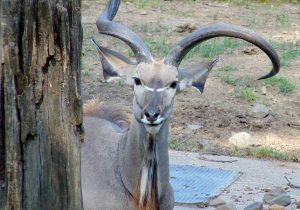
This trail made its way above and between several habitats spanning two continents from Africa (the forests & savanna) and South America (jungle).
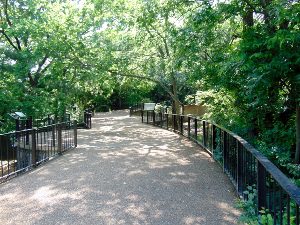
After seeing the Greater Kudu relaxing in the morning sun we encountered Yellow-backed Duiker.
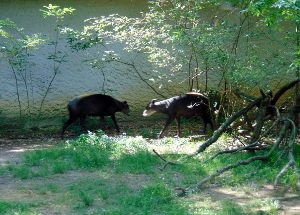
This is a small African deer species. Duiker (Die-kur) comes from an African word for “Diver” because these guys will dive into the dense brush to hide from predators. The Duiker on the right side of the trail was hidden back in the Bamboo forest, and the two mated pair on the left were chasing each other around.
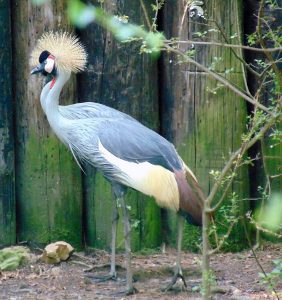
It was pretty cool to see this animal up and moving around, and yes they really do have yellow backs. Across from the Duiker is the Giant Anteater from South America. Did you know they have to walk on their knuckles because their claws are so long? They use those long claws for tearing apart Termite mounds or breaking into logs.
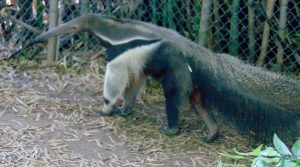
Next to the Anteaters are the Somali Wild Ass. These cute Donkey looking mixed with a bit of Zebra (on the legs) Equines are part of the Species Survival Plan since they are an endangered species. Somali Wild Ass, unlike other Horse & Donkey species, are solitary animals.
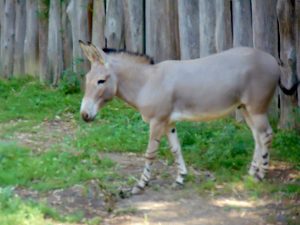
Across from their habitat are the last two habitats before you enter the Cheetah Outpost. They belong to the Red River Hogs and the very elusive Maned Wolf. When Red River Hogs are born they look completely different than their parents.
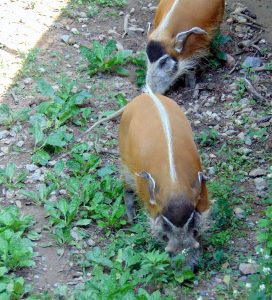
While the parents are rusty colored with a single white stripe down their backs and tufts on the tips of their ears; the babies are tawny colored with dark brown stripes and spots. They are some of the cutest little pigs I’ve ever seen.
Inside the Cheetah Outpost are some comfy chairs on the left in front of a couple TV’s showing interesting facts about Cheetah.
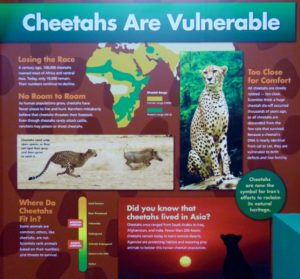
In the middle of the building behind an ominous looking black curtain is a Naked Mole Rat colony. The zoo uses black-lights and neon paint as a fun way to highlight the exhibit.
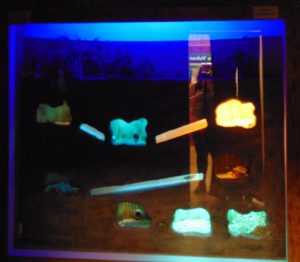
To the right before you exit onto the Cheetah Outpost Overlook there are a few Herps to check out. There is an Angolan Python and a Puff Adder to name a couple.
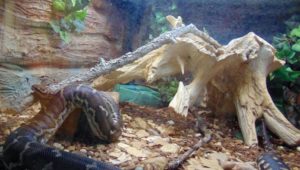
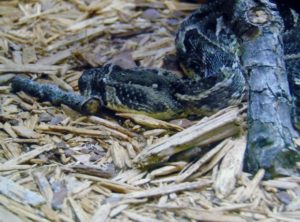
Outside the double doors to the right of the Herps is the Cheetah Overlook. Here you can see a couple different views of the Cheetah and Cheetah habitat. The day we visited the Cheetah was laying in the shade a ways off. You can get a closer view on down the trail.
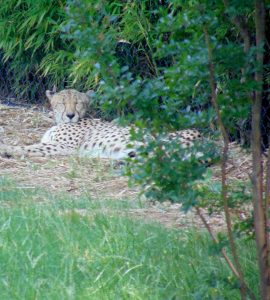
On the other side of the Cheetah Outpost is the African Crested Porcupine’s habitat. They were resting and waiting on the cool rain coming in that afternoon.
Yeah we got stuck in the rain late that afternoon.
Up the trail a bit was the habitat for one of Steve’s favorite, Kirk’s Dik-dik. They are very peculiar little (I mean tiny) antelope. To confuse predators Dik-dik run in a zig-zag pattern, this tricks the predator because they can’t tell which way the Dik-dik is going to go.
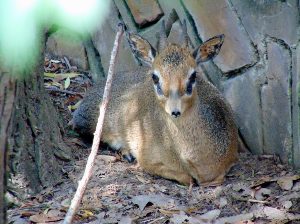
From the Dik-dik habitat there are two options as far as where to go. We decided we would go left (if facing the Dik-dik habitat) and trek the loop around the big cat area. The big cat trail loops the cat habitats.
The first species of big cat you encounter is the African Lion. They have a beautiful habitat with a waterfall, pool, and cave. In the Lion habitat you can see two large healthy females and a young male with a big beautiful full mane.

I’m not sure what the young male said to one of the females but it wasn’t good because she cornered him and smacked him for it. He got mad and his feelers were hurt, so while the girls laid on and around their giant log kopje, he went to their cave and pouted. It was too cute.
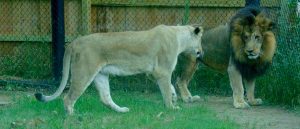
Across from the African Lion habitat is the Jaguar. Jaguars are found predominately in South America but in recent years they have been seen all the way up into the southern United States.
If you walk through an open area where there are covered viewing areas you can see the Tiger’s habitat. She was very talkative the day we were there. She has a large and awesome habitat. Like the Jaguar habitat the Tiger too had a waterfall and wading pool. Both habitats unlike the Lion habitat were steep and had great use of elevation.
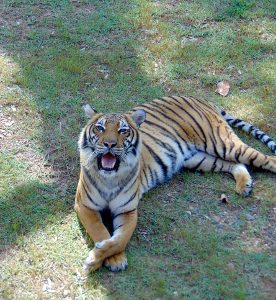
Across the trail from the Tiger habitat is the Alpaca habitat. Llamas spit; Alpacas not so much. As you make your way back down the big cat trail across from the Lions (other side) you will see the Eastern Black Rhino and their habitats.
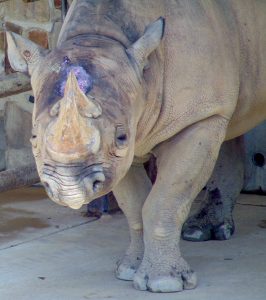
The Eastern Black Rhino is extremely endangered because of people using the Rhino horns in Traditional Medicine. A Rhino’s horn is made of Keratin, the same thing that makes up your hair and fingernails. There is absolutely no scientific evidence to support Traditional Medicines use of the Rhino horn.
A new(ish) technique conservationists have been implementing in Africa, to help deter poachers, is medically cutting off the Rhino horn. It is pretty genius, no horn on the Rhino to steal equals happy ALIVE Rhino.
As you leave the Rhino habitats you will encounter the Kirk’s Dik-dik again. Next to its habitat is the Blue Crane.
Across from both of those habitats is a closer more unobstructed view of the Cheetah habitat. There are very nice covered viewing areas for all three of these species habitats.
On up the trail to the right is the African Savanna exhibit which has Grant’s Zebra, Ostrich, Crowed Crane, and Helmeted Guinea. They have a big habitat with a large watering hole that a small stream flows from.
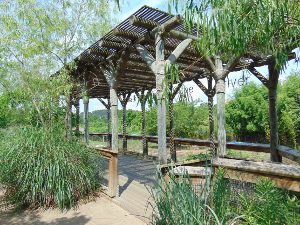
Very cool to see the co-habitation, like what you would see on the African Savanna in Africa.
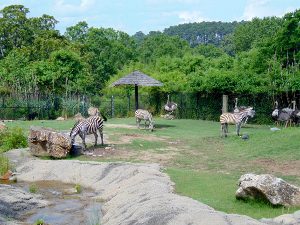
As you trek on down the trail you will see Camels off to the left near the Jambo Gym Playground.
The next exhibit showcases Bears, Otters, Bush Dog, and one other awesome species, the Woodchuck.
We started with the Woodchuck habitat. Unfortunately, the Woodchuck was a bit too hot, and he was hunkered down somewhere cool and out of view.
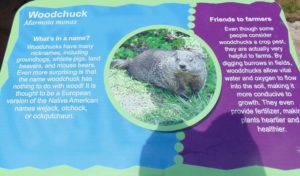
The next species we encountered was the North American River Otter. They had a great habitat with a small pool and stream, plenty of shade, and toys for enrichment. The Otter we saw was cooling off in her pool.
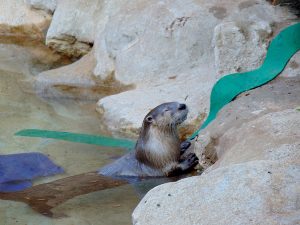
The Zoo has two different species of Otter, the North American River Otter and the Spotted Necked Otter. The Spotted Necked Otter is from Africa. The two Otter habitats were next to each other as you make your way around the loop.
The next and absolutely adorable species you will encounter is the Bush Dog. Bush Dogs are from South America, they are dogs, and they are in the canine family.
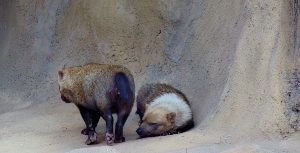
Bush Dogs usually live in groups of up to 12 individuals and all members help in raising the young. After getting some great pictures of the Bush Dogs we got to see three different species of Bears.
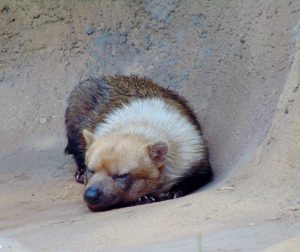
The first species we saw was the Malaysian Sun Bear. These Bears live in the tropical rainforests of Southeast Asia. They are also known as Honey Bears due to their love for, you guessed it, honey. They are excellent climbers, you have to be if you want and eat honey.
The second species we encountered was the Grizzly Bear. There were two Grizzly’s in the habitat. They had just been swimming in their pool when we got there. I could tell because their thick brown to reddish copper hair was glistening in the sun.
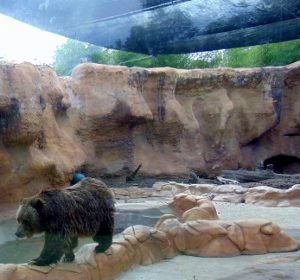
The last bear species we came to visit was the Sloth Bear. The Sloth Bear isn’t sloth like at all. They are native to the Indian Subcontinent. Their name comes from their long thick claws that are similar looking to those of the Sloth. Sloth Bears can actually run as fast as humans.
After making the loop around the River Otter, Bear, and Bush Dog habitats we turned right at the Jambo Gym Playground and walked past the Civitan Pavilion.
You can turn right at the pavilion to head to the Small Carnivore exhibit. At the start of the Small Carnivore trail you will come to view the Red Fox and their habitat first. The sweet little Red Fox was laying in the shade at the back of its habitat.
Depending on which way you go around the loop you will either see the Fossa or the Caracal next. We went right toward the Caracal habitat.
The Caracal is native to Africa and is one of the smaller feline species. Caracal can jump up in the air twice its body length. It can catch a bird mid-air.
The next species we came to isn’t a Carnivore but the habitat is perfect for this Herbivore. It is the Capybara.
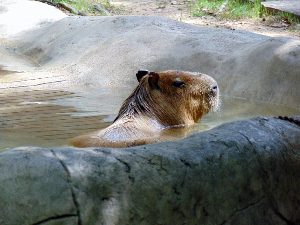
The Capybara habitat has a big pool and lots of shade for him. When we were visiting the Capybara was lounging in the pool, I don’t blame him. It was kind of warm that day, I kind of wanted to join him. Did you know they are the largest rodent in the world?
Next you will encounter another small African Cat called a Serval. They have big ears and long legs. Their long legs help them hunt and pounce on prey in the tall grasses of the African Savanna.
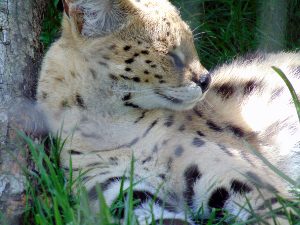
The next cat species you encounter is native to Central America and can be found as far North as Texas. This small beautiful cat is the Ocelot. They have a beautiful pattern of stripes and spots. They also have one of the sweetest faces I’ve seen.
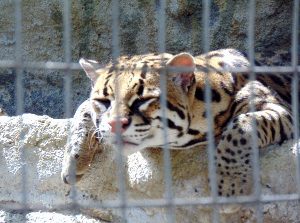
The last feline species you encounter on the Small Carnivore loop is the Clouded Leopard. These cats are the most arboreal of all the cat species. They will spend 90% of their lives in the trees in the forests of Asia.
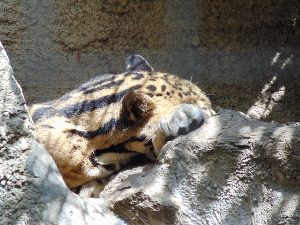
The last Carnivore we saw on the loop is the Fossa. Fossa are endemic to Madagascar and are super elusive. They are closely related to the Mongoose family.
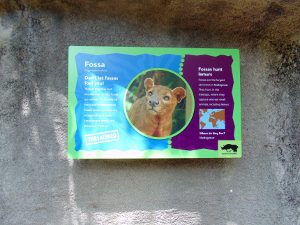
After we exited the small Carnivore loop we decided we were hungry so we headed over to Café Africa. Café Africa is located next to the Camel habitat and the Jambo Gym Playground. Café Africa is the Zoo’s main dining.
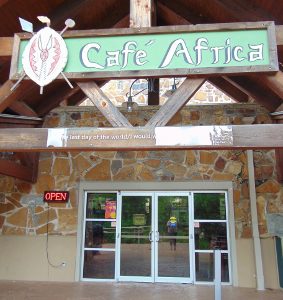
The zoo does offer two other (seasonal) concessions. The aesthetic and ambiance in Café Africa is very much African.
Steve had a cheeseburger with waffle fries and I had a BBQ pulled pork sandwich with classic potato chips. It was a great lunch.
After lunch we made our way out the south doors, we came in the west doors, and into the Arkansas Heritage Farms (children’s zoo). The trail will loop around so you can go left or right and won’t miss anything.
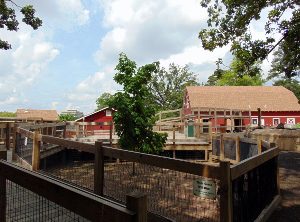
We started out in the barn where we encountered Miniature Donkey, Zebu (miniature African cattle), Miniature Horse, Boer Goats, and the cutest Pygmy Goats.
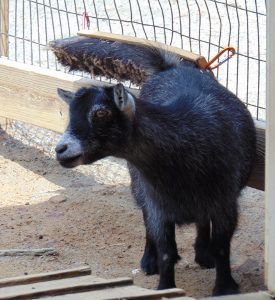
The next barn you walk through houses sheep. As you make your way left around the loop the habitat with all the holes in the ground belongs to a Giant Chinchilla Rabbit, they like to dig!
The last barn we saw (didn’t walk through, all the animals were in their day yards) is where all the bird species are.
They have five different species of Heritage Chicken. The last bird before Steve took his selfie with the Boer Goat is the Wild Turkey. He had all his feathers out and was strutting his stuff. He even gobbled a few times.
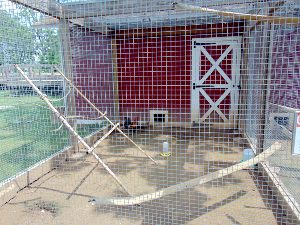
I really like this Children’s Zoo because it wasn’t just where you get to pet farm animals but you got to see where some of your food comes from.
Adjacent to the farm is the African Spur-thigh Tortoise and the Ringtail Cat habitats.
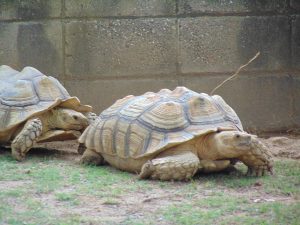
Ringtail Cats are nocturnal so unfortunately she was sleeping so we didn’t get to visit with her.
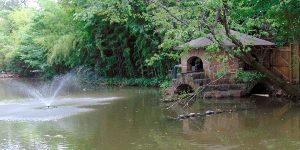
We trekked down by the Flamingos and the Water Fowl Pond before crossing the path to see the Asian Elephants.
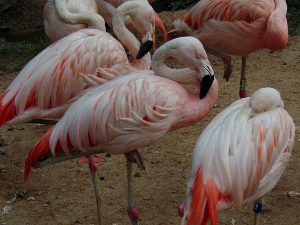
The zoo has both indoor and outdoor viewing for these big beautiful animals. The day we visited the zoo the elephants were outside enjoying browse left for them by their keepers.
From the Asian Elephant habitat you can enter the Primates, Birds, and Reptile building. In this building there is an open flight exhibit where you can more or less go bird watching as they fly and/or walk around you.
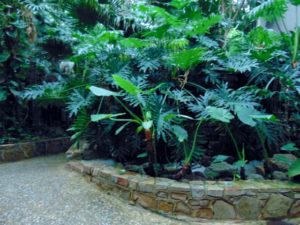
As you make your way through there and into a small hallway you will encounter your first reptile before you enter the first big room of habitats. This is the beginning of the zoo’s Herpetarium. The first reptile you encounter is the Green Basilisk.
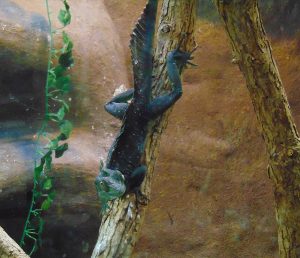
The Green Basilisk can run on top of the water for a good distance before sinking. This ability is due to the Basilisk’s large hind feet with very long toes.
Across from the Basilisk is a very large habitat belonging to a Green Iguana, Geoffroy’s Marmoset, and White-faced Saki Monkeys.
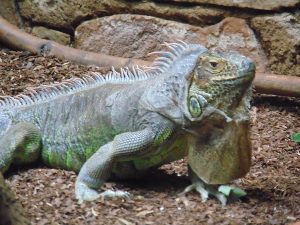
After getting some good pictures we went through another doorway (into the big room with more habitats) and entered the zoo’s main Herpetarium. Here we saw a few species we were familiar with like a Burmese Python, an Eyelash Pit Viper, a Cantil, and Leopard Gecko.

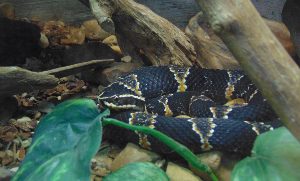
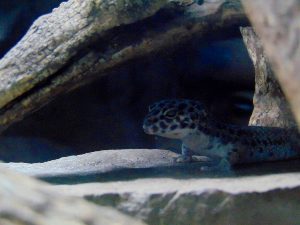
Of course, there are also the all too familiar Cottonmouth and Copperheads. However, we also encountered a few new species.
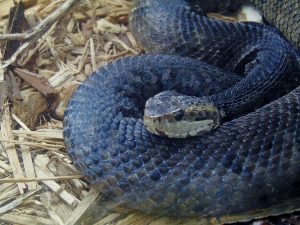
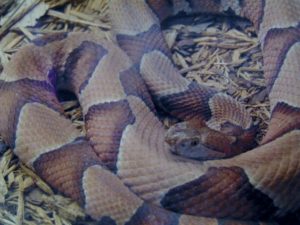
The Red Tegu, Philippine Palm Viper, and a Yellow Rat Snake are a few of those new species we saw.
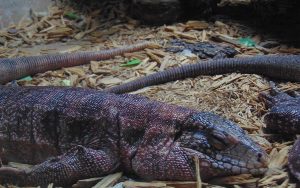
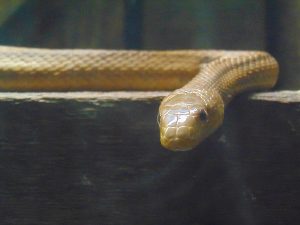
After you look at all the Herps you walk through the last door and enter the zoos Nocturnal exhibit. It is a bit dark so make sure you take the time for your eyes to adjust.
In this area you are able to see a Sloth, Moholi Bushbaby, Callimico, and a Pygmy Slow Loris. All of these tiny animals are darling.
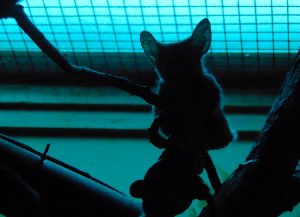
To keep them up and active for visitors to see the zoo uses light (or lack of light) to make the animals night time (when they are active) during our day time. Then when it is our night time the lights come on and it is their daytime (so they can sleep when we sleep). Kind of genius!
To the right of the Nocturnal exhibits are a few more Primates. A species new to Steve and I is the Capuchin.
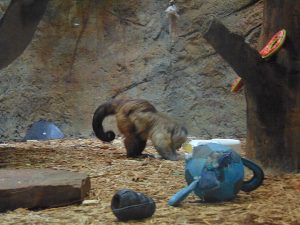
As you exit the building the last habitat you will come to is the American Alligator.
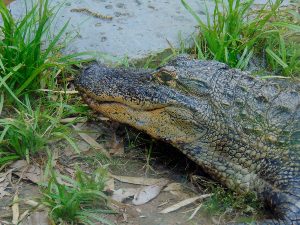
At this point in the day a few clouds had started to roll in so the Alligators were sprawled out. They were trying to get the remaining sun because like all reptiles Alligators are ectothermic, meaning they rely on the sun to help regulate their body temperature.
Last but definitely not least is the Primate Canyon exhibit.
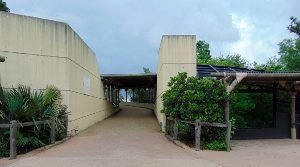
First we stopped by the Asian Falls and a beautiful Koi Pond.
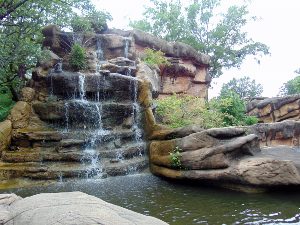
Then we trekked past the backside of the Greater Kudu and Penguin Pointe habitat until we came to the Spider Monkey Island. The Black-handed Spider Monkeys were hanging out on their second smaller island with a rock mountain.
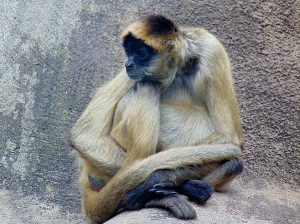
One of the Spider Monkeys was off by herself pouting because another Spider Monkey had stolen all of the lettuce leaves for himself.
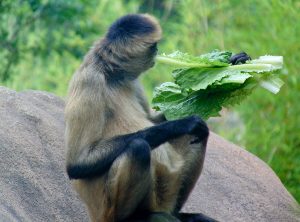
We made our way around and to the left towards Primate Canyon. The first habitat on your right (when we visited) belongs to a big male silverback Western Lowland Gorilla. At this point in the day it had started to sprinkle a bit so he decided to sit under and outcropping to keep from getting wet.
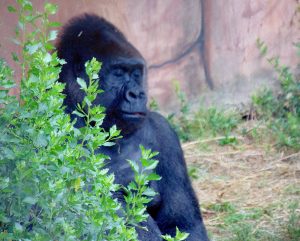
On the left is the Orangutan habitat. Their habitat is huge with plenty of stuff to climb on to survey their territory.
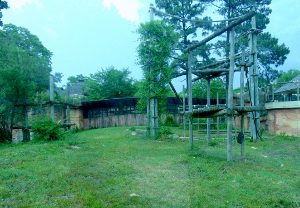
As you walk up the trail you will also be gaining elevation. There are a few covered picnic areas in the middle of all four habitats so you can have lunch with the Primates.
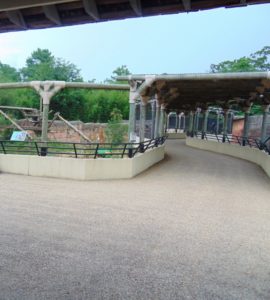
Moving on down the trail on the right is the Western Lowland Gorilla family group. These Gorillas were laying under of their covered porch areas enjoying the cooler air brought in by the rain clouds.
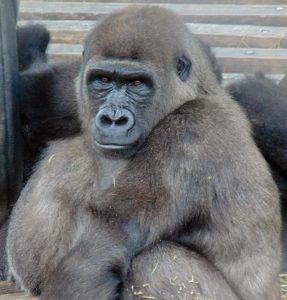
Across from the Gorillas is the Chimpanzee habitat. We watched as Grandma scouted the perimeter of their habitat. Scouting along beside Grandma was a baby with a blanket in tow. It was pretty adorable to see this little one with its blanket.
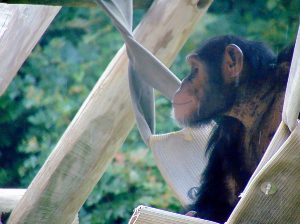
We then descended in elevation and stopped at the last Primate habitat, Lemur Island. On Lemur Island is a mix of Blue-eyed Black Lemurs, Black and White Ruffed Lemurs, and Ringtail Lemurs.
The Lemurs also share their habitat with Madagascar Teal. They are a type of duck species.
The last (or first) exhibit you will come to is the Lorikeet Landing. Here you can purchase food to feed the Lorikeets as they fly around and sometimes land on you.
After visiting the gift shop we were on the road again! Little Rock Zoo is a very neat compact zoo. I highly recommend visiting if you haven’t already. We will definitely be back to visit!!